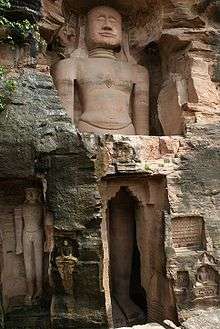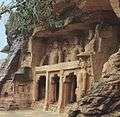Gopachal rock cut Jain monuments
| Gopachal Parvat Gopachal rock cut Jain monuments | |
|---|---|
 Adinatha | |
 Shown within India  Gopachal rock cut Jain monuments (Madhya Pradesh) | |
| Basic information | |
| Location | Gwalior Fort |
| Geographic coordinates | 26°12′55.1″N 78°10′02.9″E / 26.215306°N 78.167472°ECoordinates: 26°12′55.1″N 78°10′02.9″E / 26.215306°N 78.167472°E |
| Affiliation | Jainism |
| Deity | Tirthankaras |
| District | Gwalior |
| State | Madhya Pradesh |
| Country | India |
| Architectural description | |
| Creator | Tomaras of Gwalior |
| Date established | 7th-century |
| Completed | 15th-century |
Gopachal rock-cut Jain monuments, also called Gopachal Parvat Jaina monuments, are a group of Jain carvings dated to between 7th and 15th century. They are located on the south side of Gwalior Fort, Madhya Pradesh. They depict Tirthankaras in seated Padmasana posture as well as standing Kayotsarga posture, in the typical naked form of Jain iconography. This group of Jain monuments is related to numerous others found in the north side of the fort including the Siddhachal Caves.
Location
The Gopachal rock cut Jain monuments are located inside the fort of Gwalior, Madhya Pradesh, on a rock cliff east of the Scindia School. The Gwalior city and the fort is connected to other Indian cities by major highways NH 44 and 46 (Asian Highway 43 and 47), a railway station and airport (IATA: GWL). It is located near other historic Hindu and Jain temples from the medieval era.[1][2][3]
History
The Gopachal rock cut monuments are a part of nearly 100 Jain monuments found in and around the Gwalior city, but these are dated earlier than the Siddhachal Caves located about 2 kilometres (1.2 mi) north of these monuments. Both monuments were defaced and desecrated around 1527 when the Emperor Babur ordered their destruction.[4][5][6] Centuries later, the Jain community restored many of the statues by adding back stucco heads on the top of the damaged idols.[4]
The prolific Apabhramsha author Raidhu was responsible for consecrating many of the Jain rock carved images as attested by multiple inscriptions.[7] These include the two colossal images of Adinatha (57 feet) and Chandraprabha.[8]
Description
The Gopachal rock-cut monuments depict the Tirthankaras in seated or standing meditating positions. They are not as colossal as some of those found in the Siddhachal Caves, but they are big. The Gopachal monuments include standing and seated Rishabhanatha (Adinatha), Neminatha, Parshvanatha and Mahavira.[1][4][9][1]
According to Jains, Tirthankara Parshvanath delivered his discourse (deshna) on this hill.
Gallery
 Adinatha, 1895 photo
Adinatha, 1895 photo Jain statues
Jain statues Seated in meditating position
Seated in meditating position%2C_Gwalior_Fort_India.jpg) Parshvanatha
Parshvanatha
See also
| Wikimedia Commons has media related to Gopachal. |
References
- 1 2 3 Kurt Titze; Klaus Bruhn (1998). Jainism: A Pictorial Guide to the Religion of Non-violence. Motilal Banarsidass. pp. 106–110. ISBN 978-81-208-1534-6.
- ↑ Group of temples at Batesar, ASI Bhopal Circle (2014)
- ↑ Naresar Temples, ASI Bhopal Circle (2014)
- 1 2 3 Gwalior Fort: Rock Sculptures, A Cunningham, Archaeological Survey of India, pages 364-370
- ↑ Kurt Titze; Klaus Bruhn (1998). Jainism: A Pictorial Guide to the Religion of Non-violence. Motilal Banarsidass. pp. 101–102. ISBN 978-81-208-1534-6. , Quote: "In 1527, the Urvahi Jinas were mutilated by the Mughal emperor Babar, a fact he records in his memoirs".
- ↑ Trudy Ring; Noelle Watson; Paul Schellinger (2012). Asia and Oceania: International Dictionary of Historic Places. Routledge. p. 314. ISBN 978-1-136-63979-1.
- ↑ Phyllis Granoff 2006, p. 31.
- ↑ Phyllis Granoff 2006, p. 32.
- ↑ Gwalior Fort, Archaeological Survey of India, Bhopal Circle, India (2014)